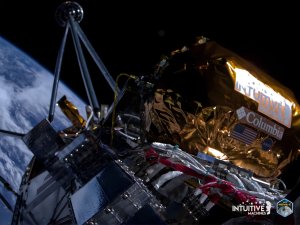Feb. 22 (UPI) — America has returned to the moon after a 52-year absence. The unmanned Odysseus spacecraft touched down on the lunar surface shortly before 6:30 p.m. EST Thursday.
“We can confirm without a doubt that our equipment is on the surface and we are on the moon. Odysseus has found a new home,” said Dr. Tim Crain, mission director of the IM-1, the first American private venture to send a module to the moon.
It’s the first time the United States has had a new presence on the lunar surface since NASA’s Apollo 11 in July 1969.
The Intuitive Machines Odysseus lunar lander, nicknamed “Odie” or “IM-1,” settled on the moon’s surface after a day’s long trek but immediately began experiencing communication problems, preventing the transmission of data.
After a tense five-minute wait, Crain confirmed that the module had touched down. The Houston-based company confirmed the landing, too.
“I know this was a nail-biter, but we are on the surface, and we are transmitting,” Intuitive Machines CEO Steve Altemus said. “Welcome to the moon.”
The condition of the lander is not yet clear. But the company has confirmed it has made contact with the craft on the lunar surface.
Crews were considering restarting the radios to improve communications as Crain confirmed that Odysseus was emanating a “faint signal” amid a smattering of rather unsure applause in mission control in Houston.
Crain mentioned during the module’s decent that it was experiencing a slight “yaw,” which meant it was not exactly lined up as it should have been, and could have affected the highly sensitive antennae and other on-board communications gear.
The Odysseus lander is one of many commercial projects being supported by NASA as part of the Artemis Initiative, which supports private space exploration ahead of the planned Artemis mission, which aims to return humans to the lunar surface.
The spacecraft was launched atop a SpaceX Falcon 9 from Kennedy Space Center in Florida on Feb. 15.
The mission was originally intended to land at the Oceanus Procellarum, but the landing site was later changed to the Malapert A region. Due to the communications problems during touchdown, the module’s exact location is not known, though it is thought to be in the target area.
“The decision to move from the original landing site in Oceanus Procellarum was based on a need to learn more about terrain and communications near the lunar south pole,” NASA said in a press release.
The mission is the second commercial mission under NASA’s Commercial Lunar Payload Services initiative and the first mission from Intuitive Machines.
“The NASA payloads will focus on demonstrating communication, navigation and precision landing technologies and gathering scientific data about rocket plume and lunar surface interactions,” NASA said.

COMMENTS
Please let us know if you're having issues with commenting.